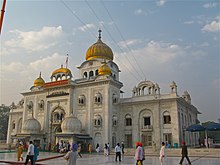Gurdwara Bangla Sahib
| Gurdwara Bangla Sahib | |
|---|---|
 Gurdwara Bangla Sahib as viewed from Main Entrance.  | |
| Religion | |
| Affiliation | Sikhism |
| Location | |
| Location | Connaught Place, Delhi, India. |
| Architecture | |
| Style | Sikh architecture, Mughal architecture |
| Founder | Sardar Baghel Singh[1][2] |
| Completed | 1664 as a bungalow, again rebuilt in 1783, current structure mostly built post 1947 |
Gurdwara Bangla Sahib () is one of the most prominent Sikh gurdwaras, or Sikh house of worship, in Delhi, India, and known for its association with the eighth Sikh Guru, Guru Har Krishan, as well as the holy pond inside its complex, known as the "Sarovar." It was rebuilt as a small shrine by Sikh General Sardar Baghel Singh in 1783. In the same year, there was reconstruction of nine Sikh shrines in Delhi. There were attempts of occupancy by Raja Jai Singh of Amer, during the reign of Mughal Emperor, Shah Alam II.[3]
It is situated near Connaught Place, New Delhi on Baba Kharak Singh Marg and it is instantly recognisable by its golden dome and tall flagpole.
History

Gurdwara Bangla Sahib was originally a bungalow belonging to Raja Jai Singh, an Hindu Rajput ruler in the seventeenth century, and was known as Jaisinghpura Palace, in Jaisingh Pura, an historic neighbourhood demolished to make way for the Connaught Place, shopping district.[4] Since Guru Har Kishan stayed at Raja Jai Singh's Banglow (pronouned "bangla" in hindi and punjabi) which has now been converted to a gurudwara, now the gurudwara is called the Bangla Sahib to memorialise Guru Har Rai's stay here.[5]
The eighth Sikh Guru, Har Krishan resided here during his stay in Delhi in 1664. He died on 30 March 1664.[6]
The gurdwara and its Sarovar are now a place of great reverence for Sikhs, and a place for special congregation on birth anniversary of Guru Har Krishan.
In March 2021, the gurdwara inaugurated the cheapest diagnostic centre with the aim to provide healthcare for the poor. The patients can get an MRI scan at ₹50.[7]
In 1984, during the anti-Sikh riots, some 150 Sikhs took sanctuary inside the gurdwara. A Hindu mob carrying cans of gasoline, attempted to storm into the temple, but were driven back.[8]
Gallery



References
- ^ Singh, Sarbpreet (26 June 2023). The Camel Merchant of Philadelphia: Stories from the Court of Maharaja Ranjit Singh. Penguin Random House India Private Limited. ISBN 978-93-5708-133-7.
In 1782, the Sikh Sardars, ever bolder, made an expedition to Delhi. Sardar Baghel Singh established a camp in Delhi and built four gurdwaras, Sis Ganj Sahib, Bangla Sahib, Rakabganj Sahib and Bala Sahib
- ^ Randhir, G.S (1990). Sikh Shrines in India. Publications Division Ministry of Information & Broadcasting. ISBN 9788123022604.
- ^ "Gurdwara Bangla Sahib - Delhi Gurdwara Bangla Sahib - Banglasahib Gurduwara New Delhi". www.bharatonline.com.
- ^ Roy, Sidhartha (1 September 2011). "A tale of two cities". Hindustan Times. Archived from the original on 2 July 2015. Retrieved 27 April 2018.
- ^ Guru Harkrishan ji an apostle of humility, Daily Excelsior, 1/8/2021.
- ^ Guru Harkrishan ji an apostle of humility, Daily Excelsior, 1 August 2021.
- ^ Khan, Sami (10 March 2021). "MRI scan at just Rs 50: Delhi's Bangla Sahib Gurudwara promises affordable healthcare [details]". www.ibtimes.co.in. Retrieved 11 March 2021.
- ^ "Angry Indian Mobs Hunt Down Sikhs". Washington Post. 2 November 1984. Retrieved 7 August 2023.
External links
![]() Media related to Gurudwara Bangla Sahib at Wikimedia Commons
Media related to Gurudwara Bangla Sahib at Wikimedia Commons
